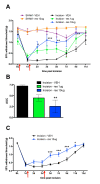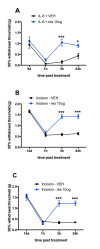Resveratrol engages AMPK to attenuate ERK and mTOR signaling in sensory neurons and inhibits incision-induced acute and chronic pain
- PMID: 22269797
- PMCID: PMC3284441
- DOI: 10.1186/1744-8069-8-5
Resveratrol engages AMPK to attenuate ERK and mTOR signaling in sensory neurons and inhibits incision-induced acute and chronic pain
Abstract
Background: Despite advances in our understanding of basic mechanisms driving post-surgical pain, treating incision-induced pain remains a major clinical challenge. Moreover, surgery has been implicated as a major cause of chronic pain conditions. Hence, more efficacious treatments are needed to inhibit incision-induced pain and prevent the transition to chronic pain following surgery. We reasoned that activators of AMP-activated protein kinase (AMPK) may represent a novel treatment avenue for the local treatment of incision-induced pain because AMPK activators inhibit ERK and mTOR signaling, two important pathways involved in the sensitization of peripheral nociceptors.
Results: To test this hypothesis we used a potent and efficacious activator of AMPK, resveratrol. Our results demonstrate that resveratrol profoundly inhibits ERK and mTOR signaling in sensory neurons in a time- and concentration-dependent fashion and that these effects are mediated by AMPK activation and independent of sirtuin activity. Interleukin-6 (IL-6) is thought to play an important role in incision-induced pain and resveratrol potently inhibited IL-6-mediated signaling to ERK in sensory neurons and blocked IL-6-mediated allodynia in vivo through a local mechanism of action. Using a model of incision-induced allodynia in mice, we further demonstrate that local injection of resveratrol around the surgical wound strongly attenuates incision-induced allodynia. Intraplantar IL-6 injection and plantar incision induces persistent nociceptive sensitization to PGE2 injection into the affected paw after the resolution of allodynia to the initial stimulus. We further show that resveratrol treatment at the time of IL-6 injection or plantar incision completely blocks the development of persistent nociceptive sensitization consistent with the blockade of a transition to a chronic pain state by resveratrol treatment.
Conclusions: These results highlight the importance of signaling to translation control in peripheral sensitization of nociceptors and provide further evidence for activation of AMPK as a novel treatment avenue for acute and chronic pain states.
Figures








Similar articles
-
Pharmacological activation of AMPK inhibits incision-evoked mechanical hypersensitivity and the development of hyperalgesic priming in mice.Neuroscience. 2017 Sep 17;359:119-129. doi: 10.1016/j.neuroscience.2017.07.020. Epub 2017 Jul 17. Neuroscience. 2017. PMID: 28729062 Free PMC article.
-
Targeting adenosine monophosphate-activated protein kinase (AMPK) in preclinical models reveals a potential mechanism for the treatment of neuropathic pain.Mol Pain. 2011 Sep 21;7:70. doi: 10.1186/1744-8069-7-70. Mol Pain. 2011. PMID: 21936900 Free PMC article.
-
IL-6- and NGF-induced rapid control of protein synthesis and nociceptive plasticity via convergent signaling to the eIF4F complex.J Neurosci. 2010 Nov 10;30(45):15113-23. doi: 10.1523/JNEUROSCI.3947-10.2010. J Neurosci. 2010. PMID: 21068317 Free PMC article.
-
Targeting AMPK for the Alleviation of Pathological Pain.Exp Suppl. 2016;107:257-285. doi: 10.1007/978-3-319-43589-3_11. Exp Suppl. 2016. PMID: 27812984 Free PMC article. Review.
-
mTOR kinase: a possible pharmacological target in the management of chronic pain.Biomed Res Int. 2015;2015:394257. doi: 10.1155/2015/394257. Epub 2015 Jan 1. Biomed Res Int. 2015. PMID: 25685786 Free PMC article. Review.
Cited by
-
The potent, indirect adenosine monophosphate- activated protein kinase activator R419 attenuates mitogen-activated protein kinase signaling, inhibits nociceptor excitability, and reduces pain hypersensitivity in mice.Pain Rep. 2016 Jul;1(1):e562. doi: 10.1097/PR9.0000000000000562. Pain Rep. 2016. PMID: 27672681 Free PMC article.
-
The modifier effect of physical activity, body mass index, and age on the association of metformin and chronic back pain: A cross-sectional analysis of 21,899 participants from the UK Biobank.PLoS One. 2023 Feb 28;18(2):e0282205. doi: 10.1371/journal.pone.0282205. eCollection 2023. PLoS One. 2023. PMID: 36854023 Free PMC article.
-
Therapeutic opportunities for pain medicines via targeting of specific translation signaling mechanisms.Neurobiol Pain. 2018 Aug-Dec;4:8-19. doi: 10.1016/j.ynpai.2018.02.001. Epub 2018 Feb 23. Neurobiol Pain. 2018. PMID: 30211342 Free PMC article.
-
Mitogen-activated protein kinase phosphatase-3 (MKP-3) in the surgical wound is necessary for the resolution of postoperative pain in mice.J Pain Res. 2017 Mar 28;10:763-774. doi: 10.2147/JPR.S129826. eCollection 2017. J Pain Res. 2017. PMID: 28405172 Free PMC article.
-
Differential involvement of reactive oxygen species in a mouse model of capsaicin-induced secondary mechanical hyperalgesia and allodynia.Mol Pain. 2017 Jan-Dec;13:1744806917713907. doi: 10.1177/1744806917713907. Mol Pain. 2017. PMID: 28587509 Free PMC article.
References
-
- Pavlin DJ, Chen C, Penaloza DA, Polissar NL, Buckley FP. Pain as a factor complicating recovery and discharge after ambulatory surgery. Anesth Analg. 2002;95(3):627–634. - PubMed
Publication types
MeSH terms
Substances
Grants and funding
LinkOut - more resources
Full Text Sources
Other Literature Sources
Medical
Miscellaneous

